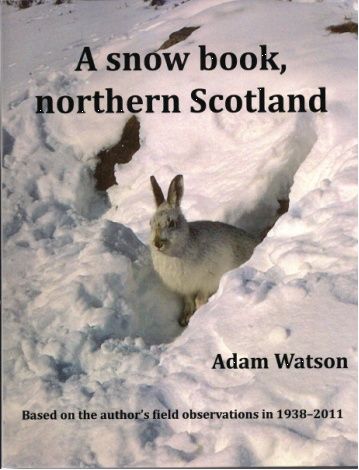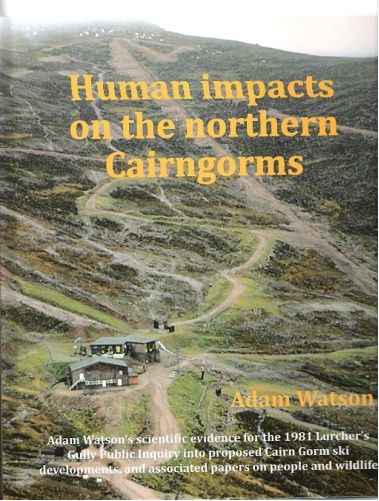It lists new and upgraded hill tracks throughout Scotland. Not surprisingly, the book is focused on track development in the north east of Scotland, where it covers all known tracks at the time of printing. References and examples are quoted from elsewhere in the Highlands but, although they are very interesting examples, they don't form a comprehensive list. The book is wide ranging and includes sections on relevant planning law and the problems facing local planning officers. Construction and reinstatement are discussed and some examples of good practice discussed. This section includes a critique on the SNH track construction guidelines. This background material is very useful for understanding why the hill track situation has developed as it has.
One of the highlights is the excellent selection of photographs. They are well-chosen to illustrate all the problems with poor construction and inadequate attention to locating tracks such that they blend into the landscape rather than disfigure it. The photographs and diagram showing the inexorable spread of new hill tracks in the Cairngorms area demonstrate, in a nutshell, why NEMT has taken a stance on the topic and, by themselves, justify buying a copy of this book.
NEMT has campaigned against the proliferation of hill tracks in recent years and this book will significantly help that campaign. In fact as part of our campaign to get the Government to rethink its recent decision to leave hill tracks as a permitted development instead of requiring planning permission, we will be sending a copy to the minister, Paul Wheelhouse.
The book is not light reading but, if you want to know more about hill tracks, it is an essential introduction.
I finish by admitting a certain degree of bias. NEMT sponsored and published this book!
2) A snow book, northern Scotland (2011)
 This is effectively
a follow-on to Cool Britannia, reviewed by Will Campbell in Issue 64.
In that book, Adam described himself as a "snow enthusiast" and
this comes across even more strongly here than in Cool Britannia. This book
takes a far wider view of snow and snow patches. Cool Britannia was
essentially a collection of evidence supporting the proposition that more
snow lay on the hills in the decades before the 1930s than subsequently. This
theme is picked up again in this book, largely focused on the north east of
Scotland and the Cairngorms, but is supplemented by a much more general discussion
on snow and snow patches including the effects on wildlife.
This is effectively
a follow-on to Cool Britannia, reviewed by Will Campbell in Issue 64.
In that book, Adam described himself as a "snow enthusiast" and
this comes across even more strongly here than in Cool Britannia. This book
takes a far wider view of snow and snow patches. Cool Britannia was
essentially a collection of evidence supporting the proposition that more
snow lay on the hills in the decades before the 1930s than subsequently. This
theme is picked up again in this book, largely focused on the north east of
Scotland and the Cairngorms, but is supplemented by a much more general discussion
on snow and snow patches including the effects on wildlife.The book is organised in a somewhat unusual fashion. Most of the chapters are stand-alone with their own summary, results, discussion, acknowledgements, references, etc. It covers snow cover on the Ben Macdui plateau, summer and autumn snow fall in the Cairngorms, snow bed survival and snow lasting through to winter and then moves to a more general discussion, including the possibility of Cairngorms glaciers in the 18th and 19th centuries! A useful list of vantage points for snow patch surveys in the north east is given. Then the book moves to descriptions of skiing in and near Aberdeen in the early 1950s, the remarkable snowstorm of early September 1976, polygonal hollows and dirt on snow surfaces, the use of snow by birds and mammals, snow features and avalanches, lichen and moss as indicators of snow-lie and finally, snow mould on hill vegetation.
There are a very large number of fascinating photographs which add enormously to the book overall. Factual descriptions are brought to life by well-chosen photographs, for example the photographs of avalanche debris are a salutary reminder of the need to remain vigilant. Most of the photographs are a joy in their own right - in places they are of coffee table standard (meant as a compliment!).
One of the appealing features in the book is the discussion of the effects on wildlife. Photographs and discussion on how mountain hare and red grouse use snow holes in the winter was fascinating. Who would have thought that otters go sledging? Aren't stags sufficiently in tune with their surroundings to not get caught in avalanches? Another feature I should have known about but didn't was the effect of lying snow on killing lichen. Once explained and illustrated with some good photographs, it becomes obvious.
As indicated above, the book starts off with a technical discussion on snow patches and how they survive or not through summer. This part is a useful collection of data from many sources brought into one place, of rather specialist appeal, and isn't light reading. The second part is lighter and more discursive.
Overall, the book is recommended reading; highly so for those with an interest in snow or for those with a desire to learn more about the wider mountain environment.
3) Some days from a hill diary (2012)
 The title leaves a
lot hanging but the sub-title gives the first clue to what this book is really
about. The entries are from the period 1943 -1950, essentially, when Adam
was a teenager.
The title leaves a
lot hanging but the sub-title gives the first clue to what this book is really
about. The entries are from the period 1943 -1950, essentially, when Adam
was a teenager. The style takes a bit of getting used to as it's very much "as it says on the tin". The book is a series of unadulterated diary entries. Most of them appear almost disconnected, although there are some entries from a series of successive days. However, the style grows on you. At the beginning, you can get left, thinking "so what", but as you progress, you realise subconsciously that these very details build the overall picture. Gems such as "so much for the notion that eagles kill most of the grouse" appearing early on create a rich tapestry. (I won't give any secrets away and will leave you, the reader, to find the context.)
In the Foreword, Adam notes that "By its very nature, any diary is partly anthropocentric and hopes that this does not intrude too much on reader's perception of the beauty of hill, weather and wildlife, or of the fine folk of the hills". In fact this is one of the charms of the book; a teenage autobiography, reminding one of Gavin Maxwell's similar autobiography from the heather moorland in south west Scotland.
The book is split into a series of chapters; each chapter being a year's highlights. The entries come mostly from Scotland and include two separate trips of about a month to Iceland and Norway. They are mostly about days when Adam was climbing or skiing and, not surprisingly, given his age, often feature his father in the early chapters. One of the first things to strike you is the large variety and numbers of birds noted. In some cases, there would have been more birds around in these areas then but also it testifies to Adam's skill as an observer that he sees more than most of us. Interestingly, you can also see early beginnings of an interest in snow patches.
As with all of Adam's books, there is a large selection of good photographs. They are, of course, black and white and give a good record of Adam growing up through his teens.
I very much enjoyed reading this and recommend it. After reading it, you will understand what lead Adam to devote his life to studying the ecology of the Cairngorms.
4) Human impacts on the northern Cairngorms (2012)
 This book is in
two main parts; the first based on Adam's scientific evidence presented to
the 1981 Lurcher's Gully Public Inquiry on proposed ski developments at Cairn
Gorm and the second part contains material on certain aspects that has subsequently
been updated as well as some completely new material. This Public Inquiry
examined human impacts for a week and remains the most thorough Inquiry on
this topic so far in Scotland.
This book is in
two main parts; the first based on Adam's scientific evidence presented to
the 1981 Lurcher's Gully Public Inquiry on proposed ski developments at Cairn
Gorm and the second part contains material on certain aspects that has subsequently
been updated as well as some completely new material. This Public Inquiry
examined human impacts for a week and remains the most thorough Inquiry on
this topic so far in Scotland.The first part discusses the physical features, landforms, soils and scientific interest of the Northern Corries and Ben Macdui plateau. The second part is written as a series of self-standing papers and looks at visitor numbers, both in summer and winter and the effects of these visitors, and their dogs, on disturbance of animals and birds, vegetation damage and soil erosion. These can lead to secondary effects, such as flash flooding which is considered. Persistence of former deer trails is discussed, showing how long it can take for restoration of damaged areas to take place.
As you would expect, the book is well stocked with excellent photographs, which help considerably to make the scientific evidence comprehensible to the lay reader. Given the nature of the book, there is a large amount of scientific tables and figures.
The book is specifically written about the northern Cairngorms. However, the principles and approaches can be extrapolated to other areas. Thus, the book has a wider significance than simply the northern Cairngorms.
The book is undoubtedly aimed at the specialist reader. However, it will interest all those with an interest in human impacts on mountainous areas. Importantly, it will provide an invaluable reference source for both planning officers and campaigners when considering the impact of future proposed developments in sensitive mountainous areas.
5) Birds in north east Scotland then and now (2012), jointly authored with Ian Francis
 Readers will all know
Adam Watson, distinguished ecologist and acknowledged expert on the Cairngorms.
However, Ian Francis is less well known. Ian has been the RSPB area manager
for north-east Scotland since 1994. He is an editor of the Scottish Ornithologist's
Club's "Scottish Birds" and has edited the "North-East Scotland
Bird Report".
Readers will all know
Adam Watson, distinguished ecologist and acknowledged expert on the Cairngorms.
However, Ian Francis is less well known. Ian has been the RSPB area manager
for north-east Scotland since 1994. He is an editor of the Scottish Ornithologist's
Club's "Scottish Birds" and has edited the "North-East Scotland
Bird Report". The book publishes Adam's field observations, and also those of friends and colleagues, mainly from the 1940s and compares them with recent records. Thus, for each bird, it builds a picture of changes in distribution and abundance since then. During the 1940s, there were few ornithologists in the area and these observations have special value.
Over 200 different birds are listed, ranging from House Sparrows to Golden Eagles, Crows to Willow Tits. There are many excellent photographs and a good set of map diagrams illustrating changes in breeding distribution for the birds where significant changes have occurred.
There are two more generally interesting Appendices on the habitat changes that have taken place since 1950 in both the Turriff and Upper Deeside areas. These habitat changes are a significant factor in the population changes that are discussed in the main body of the book, but also have a wider significance.
This book has enormous scientific value and will appeal to those with a deep interest in birds.